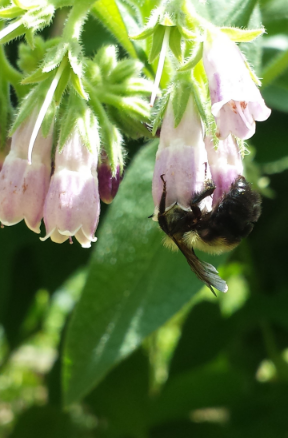Symphytum Uplandicum
Comfrey (Symphytum Uplandicum)
Whenever there is an injury, think Comfrey! She is a miraculous healer. Comfrey helps to mend broken bones, strained or torn muscles and ligaments, and heal wounds. And it works fast……..
I was given a 3 inch piece of root by a farmer who told me to break it into 4 pieces and plant them separately. I now have 4 enormous, beautiful comfrey plants! That is how quickly it regenerates itself and us!
In fact it works so quickly on a wound that you want to make sure there is no infection or dirt inside before applying the plant because it will immediately begin to heal the skin.
- Comfrey is also known as "knitbone," and no better ally for the woman with thin bones can be found
- Comfrey contains special proteins used in the formation of short-term memory cells
- It soothes and strengthens both digestion and elimination
- Keeps wrinkles at bay and the skin and scalp soft and supple
- She is loaded with calcium, chromium, potassium, amino acids and Vitamin A and D
- Its soothing mucilage adds flexibility to joints, eyes, pelvis and lungs.
- Rich in protein and folic acid
- Helps to heal injured or torn muscles or ligaments
- Helps to heal lung tissue
- Her anti-inflammatory nature, can aid in cases of arthritis
There has been debate on the effects of Comfrey on the liver. Comfrey contains alkaloids and a study was done injecting the compound over time from the roots into rats and there were some that showed liver damage. However the test was done only with the “roots” and not the leaves used in infusion, and the amounts were extremely large. Here is what my teacher Susun says:
And then the last one is an herb that I have used very consistently for more than a quarter of a century, and that’s Comfrey Leaf. Some people feel that Comfrey is not safe to use during pregnancy. Some people feel comfrey is not safe to use internally at all. I disagree. The roots of comfrey do contain compounds that are best avoided during pregnancy. (As do all parts of the wild plant.) In fact, I rarely use comfrey root because of the possibility of liver congestion, and I strongly caution those who have had hepatitis, chemotherapy, or alcohol problems to strictly avoid comfrey root. Yet even these people can benefit from use of comfrey leaf infusions. I harvest the flowering stalks when they are fully formed; and I am careful to use the cultivated garden comfrey, which grows very tall and has purplish, pinkish, bluish flowers. I avoid wild comfrey which stays rather small, even when flowering, and has cream-colored, white, or yellowish flowers.
Comfrey (Symphytum) leaf is free of the compounds (PAs) found in the root that can damage the liver. I have used comfrey leaf infusion regularly for decades with no liver problems, ditto for the group of people at the Henry Doubleday Research Foundation who have eaten cooked comfrey leaves as a vegetable for four generations.
With all of that said, I am currently drinking a quart of comfrey every 7 days, as I rotate it with my other herbs. This week I was struggling with a shoulder pull and felt tender in my ankle and wrist, so chose to drink if for 3 days in a row. This is all about listening to our own body and taking charge of our own health. I trust comfrey completely!
How would I make an infusion of Comfrey? The same way that is used for most infusions. Put 1 ounce of the dried herb in a glass quart canning jar. Pour boiling water into the jar to cover the herb and fill it up to the very top. Screw on the lid and let sit for between 4 and 10 hours. Then strain out the herb – I pour the whole jar into a mesh reusable produce bag, over a bowl or sauce pan. Then I close the bag around the herb and squeeze out all of the remaining liquid. Finally pour all of the liquid back into the canning jar. Refrigerate. Drink over ice within 2 to 2 ½ days.
How does she taste? Like a black tea, but because of the mucilage her texture is a little thicker. If you aren’t a black tea drinker, you can also mix in a pinch of dried peppermint when making the infusion to make it very refreshing. I like the taste just as she is!
Great for the muscles, the lungs, digestion and skin!
Nourishing myself from the inside,
SARAH


